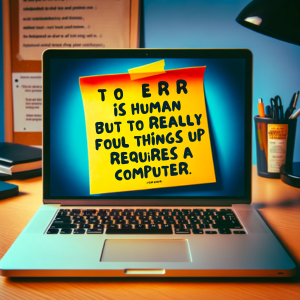Undoubtedly, a thorough understanding of management theories and principles is crucial in any career. Yet, the defining factor that transforms a good manager into an exceptional leader is the ability to communicate these ideas with enthusiasm and passion.
Mastering the art of delivering presentations is a career accelerator. It can tip a deal in your favour, capture your boss’s attention, and position you as an industry influencer. However, it’s a common observation that many presentations either send the audience to sleep or are avoided due to the presenter’s nerves. Public speaking is often ranked among the top fears, alongside things like dying or serious illness.
The real power of a presentation goes beyond charts and figures. It lies in storytelling, the use of compelling visuals, and personal charisma. For those who haven’t mastered it yet, it may seem like a magical ability, but it is a skill that can—and absolutely must—be learned.
I’ve been lucky and delivered hundreds of presentations myself to audiences all over the world and am now coaching people to do the same. Having reflected, it prompted me to delve into my past experiences and insights, particularly from old diaries and notes and create this blog post to encapsulate the essence of how to deliver a presentation and expand upon it. While I’m generally not a fan of the ubiquitous ‘top ten’ lists found online, I will adopt a similar, yet more nuanced approach here, to share these insights. If you’re looking to enhance your presentation skills further, check out my speaker coaching services where I offer personalised guidance to help you become a more confident and impactful speaker.
Planning and Preparation for Effective Presentations

Abraham Lincoln famously said, “Give me six hours to chop down a tree, and I will spend the first four sharpening the axe.” This principle applies to creating a great presentation: the key lies in the planning and preparation.
Each presentation, even with the same content, is unique due to varying factors like the venue, audience, time of day, and purpose. To thoroughly prepare, consider the following aspects:
Understanding Your Audience:
- Who are they? Consider their professional backgrounds and roles.
- What is their attitude? Assess if they are likely to be friendly, hostile, or indifferent.
- How familiar are they with your topic? Gauge their level of knowledge to tailor your content appropriately.
- What are their strengths and weaknesses? This understanding can guide the focus of your presentation.
Anticipating Audience Perception:
- How will the audience perceive you? Reflect on your own status and the power dynamics in the room.
- What should your appearance be? Decide on an attire that suits the occasion and audience expectation.
Strategising Your Approach:
- Identify common ground with your audience to establish rapport.
- What impression do you aim to create? Plan your tone and demeanour to align with this goal.
- Have you thoroughly thought through your ideas? Ensure your content is well-researched and cohesive.
- Highlight specific points: Determine the key messages you need to emphasise.
Preparing for Objections:
- Brainstorm potential objections and questions. Here, AI tools can be particularly helpful in anticipating diverse perspectives.
- Prepare answers and rebuttals to these objections to ensure a well-rounded presentation.
By addressing these points, you can shape a presentation that resonates with your audience, conveys your message effectively, and adapts to the specific context of each delivery. Remember, the more time spent in preparation, the smoother the execution will be.
Don’t rely on Technology

I love technology, especially AI. It’s amazing. It’s creative. It genuinely can help you to develop new ideas and presentations that are visually amazing. But… I’ve learnt the hard way that you can’t rely on technology working exactly how you want, especially if you’re using someone else’s tech in someone else’s office.
Sometimes technology just isn’t welcome. I once presented at an event to 25 partners in a large financial firm in London. I’d prepared 60 slides as I was due to talk for approx 60 mins but when I asked where the projector was the CEO announced, “oh no Richard, this is a powerpoint free zone” as everyone took their seats in front of me on beanbags. Good job I had some stories.
The best presentation I ever saw was delivered by a sales director to his board. He used a flip chart and in front of 20 people in real time drew a map of each region he was responsible for with a black marker pen and then presented the numbers for each. It was hypnotic, everyone hung on his every word. After the board meeting was complete I took him to one side and asked him how he managed to recreate such an accurate map for each country so quickly. He said, “it’s easy… I sneak into the room a couple of hours before and write lightly in pencil the outline of what I’m going to draw. When it’s time to present I just draw over the outline. Innovation doesn’t always mean technology.
The learning here is to learn your content and make the slides the supporting act. The audience came to see you, not the slides. If the projector from the 1990s doesn’t connect with your brand new MacBook then c’est la vie, take it in your stride and move on.
Get to the Room Early

The anticipation before speaking can be nerve-wracking, but arriving early can significantly alleviate stress. Unforeseen technical issues, from incompatible cables to last-minute software updates, always arise, and the buffer you create by being early can be a lifesaver.
Whenever possible, I visit the venue beforehand, ideally the evening before, to familiarise myself with the setting. I walk through my presentation, observing the room from the audience’s perspective, contemplating where I’ll stand, and envisioning myself delivering a successful talk. Helping to build a mental connection with the space, which can be incredibly grounding when you’re in the spotlight.
This preparation extends beyond tech checks. It’s about mentally and emotionally setting the stage for a confident and calm delivery. Transform the speaking area into a familiar territory, enhancing your control over the environment and reducing the unknowns that feed anxiety.
Limit the Fancy Fonts
When selecting fonts, it’s important to consider how easily the text can be read by everyone in your audience. Fonts that are too fancy can be challenging to decode, particularly for individuals who may have difficulty processing text. Put accessibility at the forefront of your design decisions.

A font that renders perfectly on your own system can become a garbled mess on another if it’s not widely available. Select fonts that are universally accessible across different platforms and devices. Most of the time you can’t use your own computer to run the presentation so have a copy of it (in a few different formats) on a USB stick in your pocket and note that you won’t have time to call IT to install all your fonts which the audience waits for you to start your talk.
It’s not uncommon for presentations to be shared across different operating systems, which can result in formatting errors and font substitutions if the original font is not supported. This could detract from the professionalism of your work and, worse, your message may lose its intended impact.
With these considerations in mind, I opt for Arial, a sans-serif font that is ubiquitous across operating systems and devices. For headings, a 28-point size makes an impact without dominating the slide, while a 14-point size for body text strikes a balance between detail and digestibility from any distance in the room. Citations are discreetly presented in an 8-point size, present but not distracting.
Managing Fear in Presentations

It’s natural to feel nervous before a presentation. Even with experience, this anxiety doesn’t completely vanish – I can attest to that, as I still find myself battling nerves on occasion. However, there’s a silver lining: your audience is less likely to perceive your fear than other emotions. Unlike many other emotions, fear isn’t readily apparent to others.
If your hands are shaking, a simple trick is to hold something – be it a pen, a clicker, or your notes. This not only gives you something to focus on but also stabilises your hands. As you naturally move your hands while speaking, anyone positioned more than six feet away is unlikely to notice any trembling. Remember, the physical manifestations of nervousness are often much less obvious to others than they feel to you.
Engaging with your audience is a pivotal technique for enhancing the effectiveness of your presentation and simultaneously managing your nerves. One method is to ask rhetorical questions, which can provoke thought and keep your audience mentally involved. Additionally, incorporating interactive elements such as quick polls, audience responses, or even inviting a volunteer for a demonstration can significantly increase engagement. These tactics not only make your presentation more dynamic and interesting but also shift the focus away from the presenter’s nervousness. By creating a conversational atmosphere, you reduce the feeling of delivering a monologue, thereby diminishing the intimidating aspect of public speaking. Engaging your audience in this manner transforms the dynamic from a one-way communication to a more inclusive and interactive experience. This shift not only benefits the audience through a more engaging and memorable presentation but also helps you, as the presenter, to feel more at ease and connected with your audience.
No Drink or Drugs
It might seem like a given, yet it’s a point that must be emphasised: consuming any substance that could alter your state of mind before delivering a presentation is a massive no no. This includes substances that are often socially acceptable or even recommended by some for ‘calming nerves’ or ‘boosting energy’. Your body will naturally produce adrenaline, which heightens alertness and can enhance your performance, public speaking always flies by once you get started.
Adding stimulants or depressants into the mix can unpredictably skew your natural responses. You might find your thoughts muddled, your speech hastened, and your memory compromised. This advice covers everything from coffee to alcohol, from energy drinks to illicit substances—anything that can tinker with your cognitive faculties. Bear in mind, the effects of these substances can linger as well, so what you consume the evening before can still impact your performance the next day.
The key is to trust in your preparation and your natural energy to carry you through.
Remove the Filler Words

The crutch of filler words—those ‘ums,’ ‘ahs,’ and ‘you knows’—can significantly disrupt the flow of a speech, and yet they are surprisingly common, creeping into our oral presentations almost unnoticed. They seldom have a place in written text, and ideally, they would be absent from spoken language as well, especially in professional settings.
To eliminate these verbal hiccups, immerse yourself deeply in your content well before your presentation. This level of familiarity will build your confidence and enable you to articulate your points seamlessly, diminishing the need for filler words. Aim for such a command of your material that you can anticipate your next slide, keeping your eyes and engagement with the audience rather than your notes.
Recording your rehearsals can be enlightening; playbacks will unveil any filler words that you might not be conscious of during the actual speaking. Additionally, constructive criticism from peers can pinpoint when and why you might veer into the territory of using filler words, allowing for targeted improvements.
Seek Out Low-Stakes Speaking Opportunities
Practice is the cornerstone of effective public speaking. Seek out environments where the stakes are low to hone your skills. This could be any forum where you can experiment with your delivery without the pressure of a high-stakes business outcome hanging in the balance.
Creative avenues abound for this kind of practice. Industry associations and trade bodies frequently provide platforms for aspiring speakers. For instance, the European Language Industry Association (Elia) offers numerous opportunities for participation. Beyond that, business school events, open mic nights, charity events, workshops, and even the informal stage of a karaoke bar can serve as excellent practice grounds. These settings allow you to refine your public speaking skills in a more forgiving and encouraging environment.
Taking Questions

Addressing questions during a presentation is an inevitable aspect that can be quite challenging due to its unpredictable nature. One effective strategy to manage this is the use of the ‘pivot technique,’ often employed by politicians. This approach involves initially acknowledging the question, which demonstrates that you are attentive and respectful to the audience. You might start to answer, but then skillfully shift or ‘pivot’ to a related topic or issue that you are more comfortable discussing or that aligns better with your presentation’s key messages.
For instance, if confronted with a tricky question about a specific aspect of your topic, you might pivot by broadening the scope to a more general perspective that you have prepared. This technique allows you to steer the conversation towards areas where you feel more confident and maintain control over the direction of the discussion.
However, it’s important to use the pivot technique judiciously. Overuse or obvious avoidance of direct answers can be perceived negatively by the audience. It’s a balancing act between addressing the question to the satisfaction of the audience and keeping the presentation on track with its intended purpose and flow. The goal is to engage with the audience’s queries while ensuring that the core message of your presentation remains the focal point.
In cases where you genuinely do not know the answer to a question, it’s perfectly acceptable to acknowledge this openly. Honesty in these instances can actually enhance your credibility. A constructive approach is to offer to take down the questioner’s details and commit to following up with a more informed response in due course. This not only shows your dedication to providing accurate information but also your commitment to engaging with and respecting your audience’s inquiries. Remember, it’s not about having all the answers on the spot, but about demonstrating a willingness to find them and a respect for the ongoing learning process.
How to Structure your Presentation
Keep it simple. Use this formula;
- Tell the audience what you’re going to tell them
- Tell them
- Tell the audience what you’ve told them
Effective structuring is a cornerstone of successful presentations. Here’s a straightforward formula to guide you:
Introduction (20% of Your Time):
Begin by clearly outlining what you are going to discuss. This introductory part should occupy about 20% of your presentation time. It sets the stage for your audience, outlining the expectations and the framework of your talk. Your opening statement should be concise, directly presenting the core message you intend to communicate.
Main Content (80% of Your Time):
Dedicate the majority of your presentation, approximately 80%, to the main content. This is where you delve into the specifics, elaborating on your ideas and arguments. The content should be logically ordered, ensuring a smooth flow of information that is easy for your audience to follow.
When concluding your presentation summarise the key points you’ve covered. This is not just a recap; it’s an opportunity to reinforce the most important messages and ensure they resonate with your audience.
Be explicit in signalling that the presentation is coming to an end—avoid letting it simply taper off. The summary might take longer than expected, so allocate enough time for it. Speaking slowly and clearly here is essential, as it’s your last chance to leave a lasting impression. Remember, you might find yourself enjoying the interaction, causing time to slip away faster than you realise. Planning sufficient time for a comprehensive and relaxed conclusion is critical.
Adhering to this structure helps maintain clarity and focus throughout your presentation, guiding your audience from an informative introduction, through the detailed body, to a strong and memorable conclusion.
Keep Presentations to Time

Maintaining strict adherence to the allotted time is crucial in presentations. If you are given a 30-minute slot, ensure your presentation precisely fits this timeframe. Deviating too much, whether it’s running over or finishing too early, can lead to losing your audience’s attention and engagement.
When preparing your content, be mindful of the common tendency to speak faster in front of an audience or to inadvertently omit details. A useful strategy is to have your practice sessions at home timed to finish about 15-20% over the allocated time. This buffer accounts for the accelerated pace and potential omissions during the actual presentation.
It’s essential to keep track of time while presenting. Using your slides as milestones is an effective technique. For instance, knowing that you should be on slide Y with X minutes remaining can help you pace yourself correctly. Additionally, you can request the event organiser to give you a discreet five-minute warning. This allows you the opportunity to wrap up or skip less critical points if you find yourself running behind schedule.
A large clock positioned at the back of the room can be an invaluable tool, enabling you to monitor the remaining time easily. Like many aspects of public speaking, mastering time management comes with practice and experience. By consistently being mindful of your timing, you’ll develop a natural sense for pacing and ensure your presentations are both impactful and respect the audience’s time.
Develop Yourself
Jim Rohn, a renowned motivational speaker, famously said that we are the average of the five or six people we spend the most time with. This principle holds particularly true when it comes to personal and professional development. To enhance a specific skill, such as presentation skills, it’s beneficial to surround yourself with individuals who excel in that area. People, in general, are often willing to help and share their expertise. By spending time with those who have mastered the skill you wish to develop, you not only gain insights but also get inspired by their proficiency.
In addition to choosing your company wisely, another key aspect of development is seeking regular feedback on your performances. Constructive criticism, both positive and negative, is invaluable for growth. It provides a clear perspective on your strengths and areas for improvement. Make it a habit to ask for feedback after your presentations and take the time to reflect on it genuinely. This practice can lead to significant improvements over time.
Mastering the Art of Presentation
In conclusion, this comprehensive guide underscores the importance of effective presentation skills in transforming good managers into exceptional leaders. From understanding your audience to managing fear, every aspect plays a crucial role in delivering a powerful presentation. The core of a successful presentation lies not just in the content but in the delivery, the engagement with the audience, and the personal growth of the presenter.

Remember, presentations are more than just conveying information; they are about telling a story, making a connection, and leaving a lasting impact. By following the guidelines discussed – from planning and preparation, adapting to technology, and structuring your content, to managing time, seeking feedback, and continuous self-development – you equip yourself with the tools to not only inform but also inspire your audience.
As you embark on your journey to refine your presentation skills, keep in mind that each presentation is an opportunity to learn and grow. Embrace feedback, seek opportunities to practise in diverse settings, and always be open to evolving your style and approach. The path to mastering presentations is a journey of personal and professional growth, filled with endless possibilities for innovation and connection.
Remember, the greatest asset in any presentation is you – your authenticity, your passion, and your commitment to delivering value to your audience. Let these elements shine through in every presentation you deliver, and you will undoubtedly leave a mark as a compelling and influential speaker.











Leave a Reply